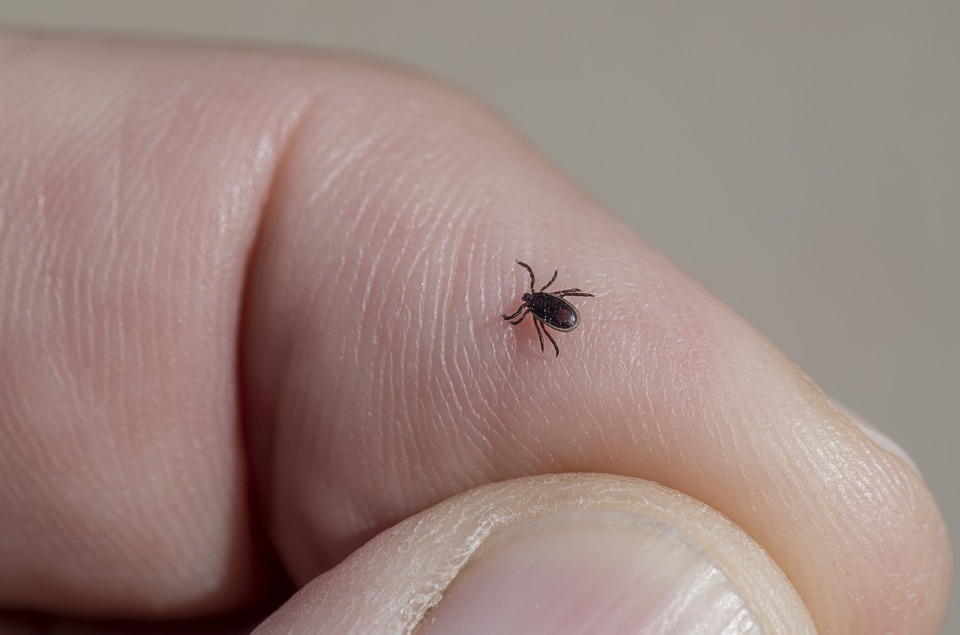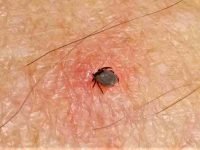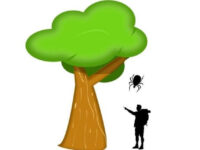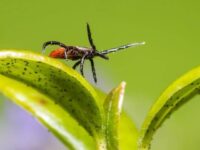Anatomy Of Ticks
The body of a tick consists of two sections. The front section is called the capitulum, which is commonly referred to as the tick head. The rest of the body is called an idiosoma.
The four pairs of legs sit on the side of the idiosoma. The legs consist of six clearly separated segments. At the tip of the front segment (tarsus) there are two claws and on the ticks (and the larvae of the leather ticks) an adhesive pad (pulvillus) to hold on to smooth surfaces.
Many types of ticks have small, inconspicuous eyes that sit in pairs on the upper side of the body. The eyes are not very developed so ticks can only see vague shapes and light and dark (scototaxis). In at least one type of tick, the camel tick Hyalomma dromedarii, optical host finding is proven by perceiving the silhouette of the host.
The two families the Ixodidae or hard ticks, and the Argasidae, or soft ticks differ in that in one family the eponymous shield (Scutum) is formed on top (dorsal) of the Idiosoma. In many types of ticks, such as the common wood tick, it covers the entire body of the male, but only about half of the female. The soft ticks are missing a shield. In addition, in the soft ticks, the capitulum with the mouthparts sits somewhat on the abdomen (ventral) of the body so that it is not visible when viewed from above.
Feeding
The main characteristic of ticks is the mouthparts on the front of the capitulum. These have been developed to facilitate blood-sucking feeding to be as effective as possible. On the outside of the capitulum, there are two claws-like extremities (palps) that are sensory organs and do not take part in the suction process. In the rest position, they often envelop the actual mouthparts. In the center sits a proboscis called a hypostome, which often has teeth that act as barbs. The two chelicerae sit on the upper side (dorsal) and are usually not visible from below. These consist of a two-part shaft, which is stretched forward parallel to the hypostome and which is immovable with a broad base on the basal part of the capitulum.
During the feeding process, the tick scratches the skin with its chelicerae and then pushes the hypostome into the wound. Contrary to popular belief, the hypostome is not a hollow proboscis: the mouth opening is basal to it on the broader base of the capitulum. This process is known colloquially as a tick bite, but more precisely it is a puncture.
When feeding, the animal creates a wound with its mouthparts by tearing open tissue with small blood capillaries. The blood that collects here is then sucked up (so-called pool feeder). Ticks with a long hypostome (prostriata) such as the common wood tick anchor themselves during the sucking process mainly with the mouthparts, ticks with a short hypostome (metastriata) such as the Dermacentor species excrete a glue-like or putty-like substance for this purpose.
The actual feeding process is relatively short with the leather ticks, about 30 to 60 minutes, the larvae are an exception. In the case of the ticks, it can last for many days to weeks. The body of the female tick can swell up to twenty times its original volume and 100 times its weight. In addition to the stretching of the cuticle, real growth processes are also involved in this. The leather ticks absorb less blood, usually about five times the body volume and ten times the weight during feeding.
When feeding, the tick releases saliva into the wound. In the species examined so far, this contains many hundreds of different proteins, most of which were not found in any other animal group. The main function of saliva is to prevent blood platelets from clotting, which would close the wound and stop the tick from feeding.
In addition, inflammatory reactions are suppressed (e.g. by prostaglandins) and the sensation of pain is inhibited in order to avoid defensive reactions on the part of the host. Inhibitors effective against hormones and signal substances such as histamine, serotonin and bradykinin can sometimes achieve several of these purposes in parallel.
The saliva released can contain a cocktail of bacteria, viruses, and other pathogens that make the tick bite particularly dangerous.
Distribution of ticks
Ticks are widespread worldwide and can be found wherever enough animals live that are suitable as hosts. The distribution of the individual species depends on the occurrence of their respective hosts and also on environmental factors such as temperature and humidity. Most tick species have one or more preferred hosts, but if there is a lack of food they can also feed on other hosts if necessary.
About twenty species of ticks occur in the temperate climatic zones of the northern hemisphere. many are native and some species have only recently been introduced from warmer climates. The most common species are the Deer Tick – Blacklegged tick (Ixodes pacificus and Ixodes scapularis), American Dog Tick (Dermacentor variability), Lone Star Tick (Amblyomma americanum), Gulf Coast Tick (Amblyomma maculatum), Brown Dog Tick (Rhipicephalus sanguineus). Some species live almost exclusively on animals or rarely pass on to humans. The most common species worldwide that parasitizes on humans is the brown dog tick (Rhipicephalus sanguineus). Most species of the soft tick family are restricted to the tropics and subtropics.
Behavior
There are basically two strategies that ticks use to find a host:
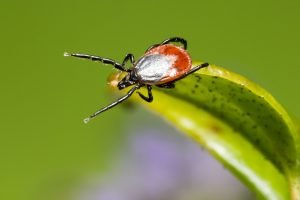 Questing ticks – sit waiting for a host. They climb onto a plant (e.g. a blade of grass or a bush) and hold on with their back legs to it. They stretch the front pair of legs far outwards in a characteristic pose so that a T-shape results. As soon as a potential host touches them, they hold onto it. This is how most ticks behave.
Questing ticks – sit waiting for a host. They climb onto a plant (e.g. a blade of grass or a bush) and hold on with their back legs to it. They stretch the front pair of legs far outwards in a characteristic pose so that a T-shape results. As soon as a potential host touches them, they hold onto it. This is how most ticks behave.
Only a few species of ticks are active hunters, ones that crawl around in search of host organisms. At 15 to 20 feet per hour, they are faster than Roman snails. Various chemical senses are used to find a host, especially carbon dioxide sensors, which are located in a special organ on the last leg (Haller’s organ). The brown dog tick is an example of a hunter.
In the case of the male ticks, a meal of blood usually only lasts a few days, as they only need blood for their own nutrition. You can suck blood multiple times while waiting for a female. The females are not only dependent on blood for their own nutrition, but also for egg production and therefore need a much larger amount of blood. A blood meal can last for weeks if undisturbed.
Host finding
The ticks use their Haller organ to find the food victim. This pit-shaped chemoreceptor, which is equipped with sensory bristles, is located on the last leg element (the tarsus) of the first pair of legs and can detect substances such as ammonia, carbon dioxide, lactic acid and, above all, butyric acid, which are given off by the host animals through breath and sweat. In the questing position (the front pair of legs is stretched forward, pivoting slightly, with the back three pairs of legs they clasp their hide), this organ is stretched out so that the ticks can better receive the sensory stimuli. The waiting ticks immediately switch from the waiting position (the folded forelegs are close to the body) to the lurking position when they notice olfactory stimuli, changes in light – especially from light to dark – or vibrations that a host may be approaching. They then cling to everything that touches their respective whereabouts and then often crawls around the body of animals and humans for up to several hours until they have found a suitable puncture site. Ticks are very picky and prefer slightly moist, warm, and thin skin with a good blood supply. In humans, the hollows of the knees, the hairline, the groin, and the fine skin behind the ears are particularly popular targets.
After the blood meal is finished, they drop off their host and the females then look for a sheltered spot on the ground to lay eggs. Egg-laying can take several days, with an egg being laid about every ten minutes. After one has emerged from the abdominal opening, it is guided past a gland with the mouthparts and provided with a protective layer that protects the fresh egg from drying out. When the ticks lay eggs, thousands of eggs are produced (up to 20,000 in the genera Hyalomma and Amblyomma), after which the female dies.
Soft-tick species, which have to feed much more often than black-back ticks, are therefore found almost exclusively in their hosts’ nests, buildings or hiding places (few tropical species are active hunters). In contrast to the tick, the female eats blood several times in a row and then lays eggs each time (up to seven times). The number of eggs is smaller every time. They withdraw into crevices and corners after every blood meal and then wait until a host comes within range again. Species of the large genus Ornithodoros that infest migratory birds can wait for the time in the nest while their host is absent. It is reported that leather ticks can survive waiting for many years without eating. Ornithodoros papillipes hold the record for eleven years without eating.
Life cycle of ticks
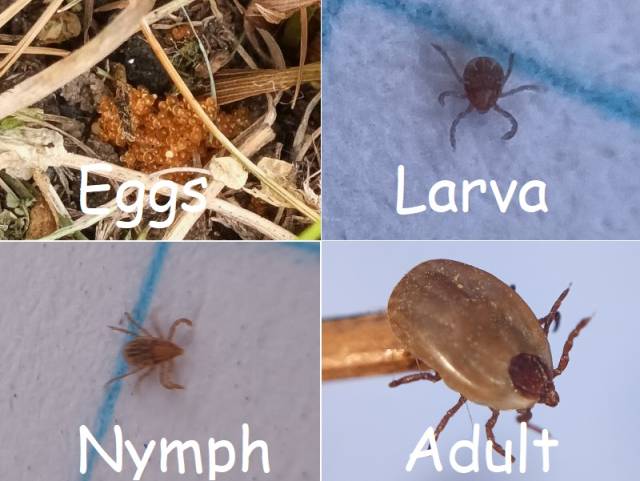
The Argasidae (soft ticks) have two to eight nymph stages. Every larva and nymph is dependent on the blood of a host. The same host species is often attacked in all stages. With the soft ticks, fertilization of the female takes place away from the host in the environment (mostly in the host’s burrow or nest). The animals find each other through signal substances (pheromones). These often have an effect on older nymphs. A substance that acts as a pheromone is the guanine contained in the feces.
In the case of the Ixodidae (shield ticks) there is only one nymph stage. In many species, the animals change host species between the various stages, often as they increase in size. However, there are species in which the molt from larva to nymph takes place on the host, sometimes even both molting, so that only the mature female leaves the host (two- and one-host species, e.g. genus Rhipicephalus ).
In many species, larvae and nymphs remain in the burrow or in the host’s nest. All three stages are less common in the wild. In the case of the common wood tick, z. B. from the egg the six-legged larva. This looks for a suitable intermediate host (rodent) after just a few days, sucks in there and takes in blood within two to three days.
After feeding, it falls off and sheds its skin after a few months to become the first eight-legged nymph, around 1.5 to 2 mm in size. This now again looks for a larger host (second intermediate host – cat) and also sucks blood there. Under moderate climatic conditions, most of the nymphs that have molted in summer or autumn do not immediately look for a new host for a blood meal, but at temperatures below 7 ° initially go into a dormant state until next spring (can also be in particularly mild winters fail). Only after this break do they look for a host and then another molt to the adult takes place. The adult animal then infests the final host (humans, large mammals). Mating takes place on the host, after which the male dies. The female drops after this last blood meal and lay its eggs shortly afterward.
